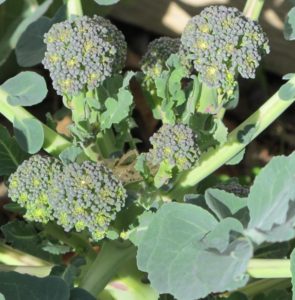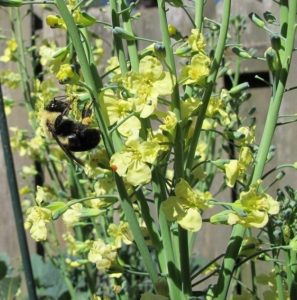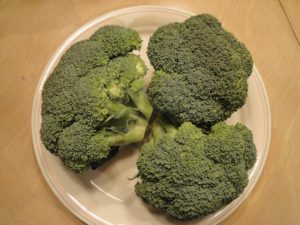Page 2
Broccoli

For cold season growing, I like broccoli ‘Arcadia’.
When choosing among varieties of broccoli, consider the timing. Look for heat tolerant cultivars, since spring-sown plants will be heading up in warming temperatures.
Broccoli doesn’t grow well in mid-summer’s hot temperatures, although it can be seeded, under light shade, after mid-summer for fall and winter crops. ‘Green Magic’ and ‘Imperial’ are good choices for the spring garden, and then, in the fall, I’ll grow ‘Arcadia’ again. I have never been disappointed by ‘Arcadia’s winter hardiness, even in the colder Maryland garden. A temporary cover might be all that is needed to see it through the winter.
Seeds germinate uniformly at soil temperatures between 65° and 80°. Colder soil causes erratic germination. Keep the soil pH between 6.5 and 7.3 for broccoli, which is slightly acidic to slightly alkaline.
I’ll sow a couple of seeds in each cell of a market pack, using seedling mix, and snip off the weakest seedling in each cell. The thinnings won’t be wasted; they’ll go into a salad or soup, or be eaten raw. As soon as the seeds have germinated, expose the plants to cooler air temperatures, in the 50’s and low 60’s. Transplants are ready to go into the garden 3 or 4 weeks after seeding and after hardening off (Page 3). (***Update***: with the increasing cost of seeds, I’m now sowing only 1 per cell, and culling the few weakest seedlings. January 2023)
Improve the Soil for Cool Season Greens
All brassicas (also known as or cole crops or cruciferous vegetables [formerly the Cruciferae family]) like well-prepared soil that’s kept evenly moist. Incorporate 2″ or 3″ of compost and/or aged manure into the top 6″ of garden soil.
Every 3 weeks after planting, fertilize with fish emulsion, earthworm castings, or farm-and-ocean products (such as Sea-Plus or Neptune’s Harvest). These fertilizers keep the plants growing vigorously. Look for one that contains boron, a micronutrient that helps prevent “hollow core” and blackening parts of the broccoli crown. During especially rainy periods, you might need to fertilize more often because nitrogen leaches quickly through the soil.
Common causes of failure with brassicas include dry, compacted soil, the caterpillars, and underfertilizing.
Harvesting and Side Shoots

‘Arcadia’ broccoli side shoots, January in NC.
Standard heading broccoli matures in 50 to 70 days from transplant, depending on cultivar. Cut the head while it is still firm and full of densely packed flower buds. When the buds begin opening up, revealing yellow flowers within, the head is past its prime, but still edible.
Make an angled cut through the stem to help shed water from the wound.
Two or three weeks later, side shoots will begin maturing. Usually, several side shoots arise from near the top of the plant (photo, right). When harvesting side shoots, you can cut the stem one or two leaves below the side shoots, and use the tender leaves, too, in the kitchen. ‘Arcadia’, in particular, grows several rounds of side shoots and might continue for months, in the right conditions.
Phytonutrients In Brassicas
We grow several kinds of brassicas. Because they’re nutrient-dense, they’re on the table every day in one form or another. The fresher they are, the more nutrients they contain. Avoid boiling or cooking them at high heat, both of which diminish the available nutrients.
Various phytonutrients in brassicas are available at different stages of preparation for cooking:
- raw (when preparing broccoli or cauliflower for dinner, I always eat a few raw pieces),
- chopped and cooked immediately,
- chopped and cooked a while later (30-40 minutes). As long as chopped broccoli stays uncooked, myrosinase, an enzyme, works to release the beneficial sulforaphane (a powerful antioxidant that helps prevent cancer) from the damaged cells. The cooking process, however, destroys the enzyme. So, if you cook it right after cutting it, you’ll get other nutrients, but not the sulforaphanes.
When the Brassicas Bloom

Bumble bee on broccoli flowers in spring.
Brassica flowers provide nectar and pollen for many kinds of beneficial insects looking for food sources when not many are available in late winter. Keeping the flowers will establish populations of tiny braconid wasps, which feed on the pollen. The braconid wasps consume and parasitize aphids in large numbers when they arrive. Pollinating bees are grateful for this source of sustenance.
Tender clusters of buds at the ends of flowering stems are edible. Just snap them off and eat fresh or lightly cooked.
Mini Broccoli
Early Sprouting Broccoli and Broccoli ‘Spring Raab’
Related to the standard broccolis are the early sprouting broccolis and ‘Spring Raab’. All have smaller heads than heading broccoli and require less growing time to first harvest. You can even find purple- and white-headed varieties.
Broccoli ‘Happy Rich’
‘Happy Rich’, an early sprouting type, is one of my favorites. It makes a single head of broccoli 1½” to 2″ wide, but several inches of tender stem and attached leaves also are edible. I grew ‘Aspabroc’ this year but prefer ‘Happy Rich’.
Given morning sun and some afternoon light shade in warm regions, ‘Happy Rich’ (Johnny’s Selected Seeds) produces shoots for a long period of time, often into summer. Stems are much more tender in moist soil heavily amended with aged cow manure and compost.
Cut 5-10″ of the stem when harvesting, preferably before the white flowers open. But, if you notice buds beginning to open up, cut the stems right away, and enjoy the flowers as well. The plant will branch out, forming new stems several times before it tires out or the weather gets too hot.
Imagine the flavor of broccoli and square it. That approximates the flavor of this variety. When lightly steamed with white button mushrooms, fresh garlic, olive oil, butter, and a dash of Kosher salt, several stems make an elegant dish by itself (“Easy Broccoli One”), with grilled fish, or as a topping on pasta.
Eaten raw or cooked 40 minutes after chopping it, ‘Happy Rich’ and other brassicas provide sulforaphane, a powerful antioxidant not found in other families of crops.
- Miniature broccoli ‘Happy Rich’ my favorite vegetable.
- Broccoli ‘Happy Rich’ regrowing after another harvest (early May 2022).
Who’s My Favorite?
This section added 1/25/2023.
***Update***: After moving to this zone 7 rural property in October 2021, I immediately went to work preparing the gardens. I grew ‘Happy Rich’ from seed and transplanted them into the garden in early March 2022. They produced harvests through the entire season. Even through the hot rainy summer of 2022, those plants continued producing stems until a sudden hard freeze (0° wind chill) killed them on Christmas Eve! So, now I can call ‘Happy Rich’ my favorite vegetable, for its productivity and longevity in the garden.
Massive white oak trees cast light shade on the big fenced garden during the hottest hours of the day. I had buried large quantities of leaves into the top 12″ of the soil before I planted anything. And a thick layer of these leaves mulched the soil (photos, above), keeping it moist and relatively cool.
We know broccoli and the other brassicas are good for us, but now we know why. They have lots of Vitamins A (carotenoids), B complex (but not B-12), C, and K, fiber, minerals (including calcium, iron, magnesium, manganese, potassium, and zinc), and even protein and Omega-3 fatty acids.
But where the brassicas outdo all other vegetables is their antioxidant content. Numerous forms of glucosinolates are found in the brassicas, including the precursor of sulforaphane. These phytonutrients have anti-inflammatory properties and can help prevent many illnesses, including several types of cancer.
Gai Lan and ‘De Cicco’
Gai lan, or Chinese broccoli, sometimes appears in our grocery store. It’s mostly leaves and stems, with small heads of white flowers, similar to ‘Happy Rich’. I use it in soups, stir-fries, as a side dish, and with pasta…anywhere broccoli is used.
Some people might detect more bitterness than broccoli, but that’s not my experience. As with all brassicas, they’re sweeter in cool to cold weather and in moist soil heavily amended with compost and aged manure. But some researchers claim brassica bitterness derives from beneficial nutrients and should not be avoided. (***Update***: Gai lan planted in March 2022 lasted all summer, which was hot and rainy.)
‘De Cicco’, another early sprouting broccoli, is an Italian heirloom. It produces heads about 3-4″ in diameter and grows a large number of side shoots after the initial cut.
Sowing Seeds
The mini, or early sprouting, broccolis germinate quickly in 70° to 80°F soil. Give them direct sunlight as soon as they germinate to avoid stretched stems. Once the seeds sprout, drop the air temperature to the high 50’s to low 60’s. Plant them outside when they’re about a month old.
Transplants that have been hardened off (described on Page 3) tolerate frost. Space them 12″ to 16″ apart in the garden and fertilize every 2 to 3 weeks. All the cool season greens respond to moist, well-enriched garden soil.
If cold weather prevents planting out, protect the seedlings in a cold frame or plant them under a low tunnel, made of clear plastic sheeting over a low frame. Light is better outside for these fast-growing seedlings. Keeping them in small pots for too long stresses the plants and will result in a disappointing crop.
Late Sprouting Broccoli
This group of broccoli includes the late sprouting varieties, grown in autumn. Varieties, such as ‘Red Fire’ and ‘Santee’ require vernalization, or several weeks of temperatures from the high 30’s to 50° in order for the heads to develop. Johnny’s Selected Seeds reports that ‘Red Fire’ is more cold tolerant than ‘Santee’ but needs longer vernalization.
These hybrids take longer to grow to harvest, about 90 to 140 days, depending on cultivar. Warm temperatures during heading turns them bitter.
‘Red Fire’ would make a stunning addition to the winter garden. That’s a purple-budded variety that takes 140 days to grow, but it won’t tolerate temperatures below 20°F.
Headings
Page 1: Starting Seeds for Cool Season Greens, The First of the Cool Season Greens: Spinach (Spinach from Seed Is Easy!, ‘Monstrueux de Viroflay’, Spinach Bowl, Harvesting Spinach), And Then the Brassicas (Include On the Label, Damping-Off, Caterpillars on Cool Season Greens, Bacillus Thuringiensis [Bt], How Does Bt Work?)
Page 2: Broccoli (Improve the Soil for Cool Season Greens, Harvesting and Side Shoots, When the Brassicas Bloom), Mini Broccoli (Early Sprouting Broccoli and ‘Spring Raab’, Broccoli ‘Happy Rich’, Who’s My Favorite?, Gai Lan and ‘De Cicco’, Sowing Seeds, Late Sprouting Broccoli)
Page 3: Dinosaur Kale, Hardening Off Cool Season Greens (Gradual Changes), Growing Plants Under Lights (More Tips Using Artificial Light), Getting More Cool Season Greens Into Your Diet, A Veggie Omelet Recipe Using Cool Season Greens



